stop start SKODA OCTAVIA 2009 2.G / (1Z) Owner's Manual
[x] Cancel search | Manufacturer: SKODA, Model Year: 2009, Model line: OCTAVIA, Model: SKODA OCTAVIA 2009 2.G / (1Z)Pages: 304, PDF Size: 19.56 MB
Page 36 of 304
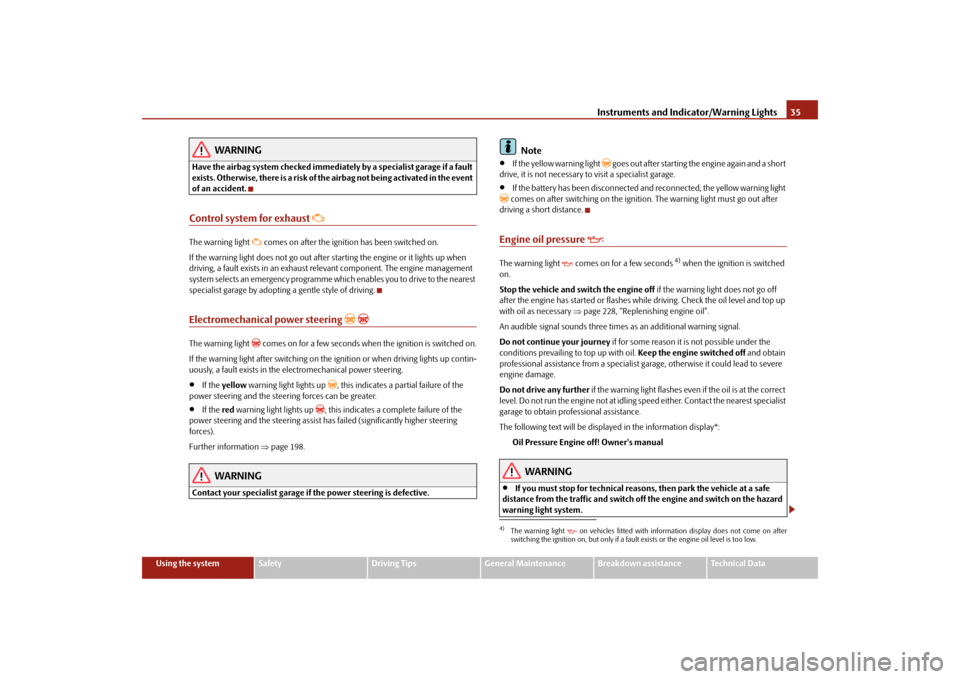
Instruments and Indicator/Warning Lights
35
Using the system
Safety
Driving Tips
General Maintenance
Breakdown assistance
Technical Data
WARNING
Have the airbag system checked immediat
ely by a specialist garage if a fault
exists. Otherwise, there is a risk of th
e airbag not being activated in the event
of an accident.Control system for exhaust
The warning light
comes on after the ignition has been switched on.
If the warning light does not go out after starting the engine or it lights up when driving, a fault exists in
an exhaust relevant componen
t. The engine management
system selects an emergency programme which enables you to drive to the nearest specialist garage by adopting a gentle style of driving.Electromechanical power steering
The warning light
comes on for a few seconds when the ignition is switched on.
If the warning light after switching on the ig
nition or when driving lights up contin-
uously, a fault exists in the el
ectromechanical power steering.
•
If the
yellow
warning light lights up
, this indicates a partial failure of the
power steering and the steering forces can be greater.•
If the
red
warning light lights up
, this indicates a complete failure of the
power steering and the steering assist has failed (significantly higher steering forces). Further information
⇒page 198.
WARNING
Contact your specialist garage if
the power steering is defective.
Note
•
If the yellow warning light
goes out after starting the engine again and a short
drive, it is not necessary to visit a specialist garage.•
If the battery has been disconnected and reconnected, the yellow warning light
comes on after switching on the ignition. The warning light must go out after driving a short distance.Engine oil pressure
The warning light
comes on for a few seconds
4) when the ignition is switched
on. Stop the vehicle and sw
itch the engine off
if the warning light does not go off
after the engine has started or flashes while driving. Check the oil level and top up with oil as necessary
⇒page 228, “Replenishing engine oil”.
An audible signal sounds three times as an additional warning signal.Do not continue your journey
if for some reason it is not possible under the
conditions prevailing
to top up with oil.
Keep the engine switched off
and obtain
professional assistance from a specialist garage, otherwise it could lead to severe engine damage. Do not drive any further
if the warning light flashes even if the oil is at the correct
level. Do not run the engine not at idling
speed either. Contact the nearest specialist
garage to obtain professional assistance. The following text will be displayed in the information display*:
Oil Pressure Engine off! Owner's manual
WARNING
•
If you must stop for technical reasons, then park the vehicle at a safe
distance from the traffic and switch off the engine and switch on the hazard warning light system.4)The warning light
on vehicles fitted with information display does not come on after
switching the ignition on, but only if a fault exists or the engine oil level is too low.
se0.1.book Page 35 Friday, April 10, 2009 3:19 PM
Page 37 of 304
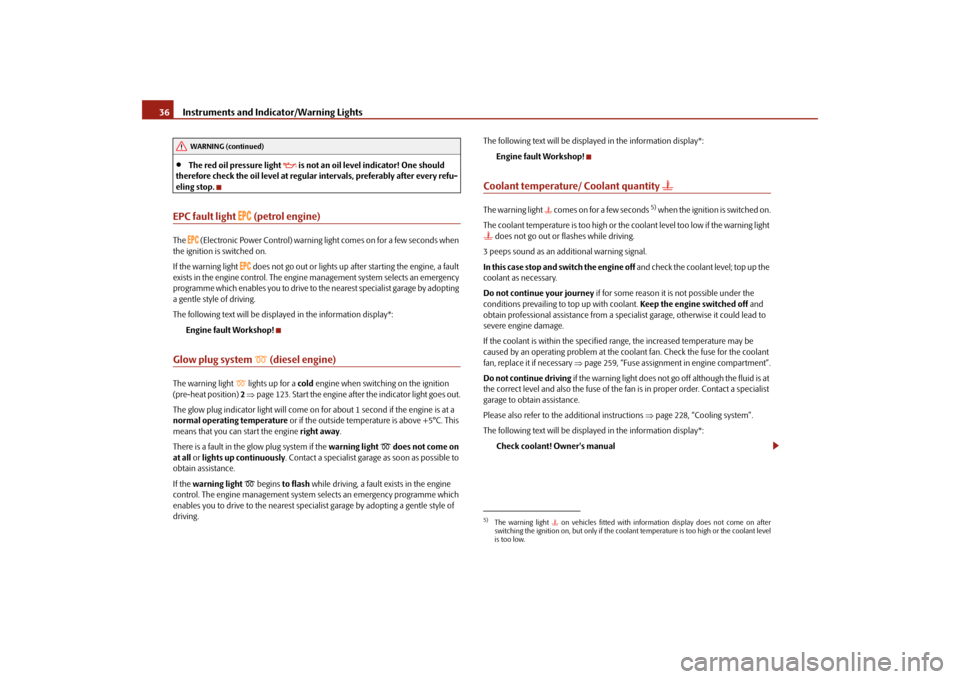
Instruments and Indicator/Warning Lights
36
•
The red oil pressure light
is not an oil level indicator! One should
therefore check the oil level at regular
intervals, preferably after every refu-
eling stop.EPC fault light
(petrol engine)
The
(Electronic Power Control) warning light comes on for a few seconds when
the ignition is switched on. If the warning light
does not go out or lights up
after starting th
e engine, a fault
exists in the engine control. The engine management system selects an emergency programme which enables you to drive to the nearest specialist garage by adopting a gentle style of driving. The following text will be displayed in the information display*:
Engine fault Workshop!
Glow plug system
(diesel engine)
The warning light
lights up for a
cold
engine when switching on the ignition
(pre-heat position)
2 ⇒page 123. Start the engine after the indicator light goes out.
The glow plug indicator light will come on for about 1 second if the engine is at a normal operating temperature
or if the outside temperature is above +5°C. This
means that you can start the engine
right away
.
There is a fault in the glow plug system if the
warning light
does not come on
at all
or lights up continuously
. Contact a specialist garage
as soon as possible to
obtain assistance. If the
warning light
begins
to flash
while driving, a fault exists in the engine
control. The engine management system
selects an emergency programme which
enables you to drive to the nearest specialist garage by adopting a gentle style of driving.
The following text will be displayed in the information display*:
Engine fault Workshop!
Coolant temperature/ Coolant quantity
The warning light
comes on for a few seconds
5) w h e n t h e i g n i t i o n i s s w i tc h e d o n .
The coolant temperature is too high or the coolant level too low if the warning light does not go out or flashes while driving.3 peeps sound as an additional warning signal.In this case stop and switch the engine off
and check the coolant level; top up the
coolant as necessary. Do not continue your journey
if for some reason it
is not possible under the
conditions prevailing to
top up with coolant.
Keep the engine switched off
and
obtain professional assistance from a specialist garage, otherwise it could lead to severe engine damage. If the coolant is within the specified range, the increased temperature may be caused by an operating problem at the coolant fan. Check the fuse for the coolant fan, replace it if necessary
⇒page 259, “Fuse assignment in engine compartment”.
Do not continue driving
if the warning light does not go off although the fluid is at
the correct level and also the fuse of the fan is in proper order. Contact a specialist garage to obtain assistance. Please also refer to the additional instructions
⇒page 228, “Cooling system”.
The following text will be displayed in the information display*:
Check coolant! Owner's manual
WARNING (continued)
5)The warning light
on vehicles fitted with information display does not come on after
switching the ignition on, but only if the coola
nt temperature is too high or the coolant level
is too low.
se0.1.book Page 36 Friday, April 10, 2009 3:19 PM
Page 38 of 304
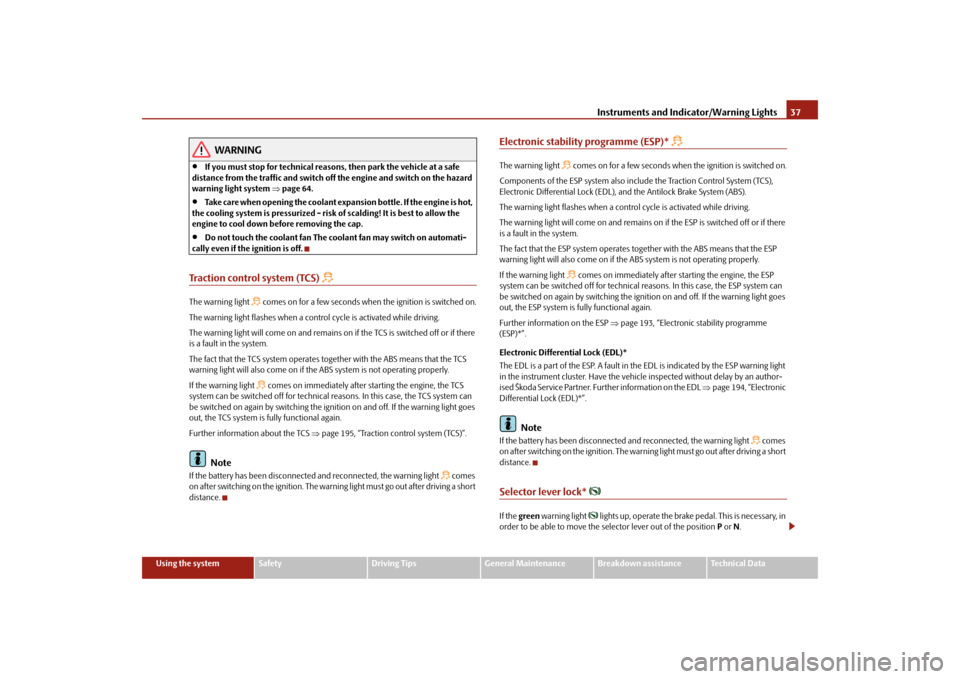
Instruments and Indicator/Warning Lights
37
Using the system
Safety
Driving Tips
General Maintenance
Breakdown assistance
Technical Data
WARNING
•
If you must stop for technical reasons, then park the vehicle at a safe
distance from the traffic
and switch off the engine and switch on the hazard
warning light system
⇒page 64.
•
Take care when opening the coolant expa
nsion bottle. If the engine is hot,
the cooling system is pressurized - risk of scalding! It is best to allow the engine to cool down before removing the cap.•
Do not touch the coolant fan The coolant fan may switch on automati-
cally even if the ignition is off.Traction control system (TCS)
The warning light
comes on for a few seconds when the ignition is switched on.
The warning light flashes when a cont
rol cycle is activated while driving.
The warning light will come on and remains on
if the TCS is switched off or if there
is a fault in the system. The fact that the TCS system operates together with the ABS means that the TCS warning light will also come on if the
ABS system is not operating properly.
If the warning light
comes on immediately after starting the engine, the TCS
system can be switched off for technical
reasons. In this case, the TCS system can
be switched on again by switching the ignition on and off. If the warning light goes out, the TCS system is fully functional again. Further information about the TCS
⇒page 195, “Traction control system (TCS)”.
Note
If the battery has been disconnected
and reconnected, the warning light
comes
on after switching on the ignition. The warn
ing light must go out after driving a short
distance.
Electronic stability programme (ESP)*
The warning light
comes on for a few seconds when
the ignition is switched on.
Components of the ESP system also incl
ude the Traction Control System (TCS),
Electronic Differential Lock (EDL),
and the Antilock Brake System (ABS).
The warning light flashes when a control cycle is activated while driving.The warning light will come on and remains on
if the ESP is switched off or if there
is a fault in the system. The fact that the ESP system operates together with the ABS means that the ESP warning light will also come on if the ABS system is not operating properly. If the warning light
comes on immediately after starting the engine, the ESP
system can be switched off for technical
reasons. In this case, the ESP system can
be switched on again by swit
ching the ignition on and off. If the warning light goes
out, the ESP system is fully functional again. Further information on the ESP
⇒page 193, “Electronic
stability programme
(ESP)*”. Electronic Differential Lock (EDL)* The EDL is a part of the ESP. A fault in the EDL is indicated by the ESP warning light in the instrument cluster. Have the vehicle inspected without delay by an author- ised Škoda Service Partner. Further information on the EDL
⇒page 194, “Electronic
Differential Lock (EDL)*”.
Note
If the battery has been disconnected
and reconnected, the warning light
comes
on after switching on the ignition. The warn
ing light must go out after driving a short
distance.Selector lever lock*
If the
green
warning light
lights up, operate the brake pedal. This is necessary, in
order to be able to move the selector lever out of the position
P or N.
se0.1.book Page 37 Friday, April 10, 2009 3:19 PM
Page 39 of 304
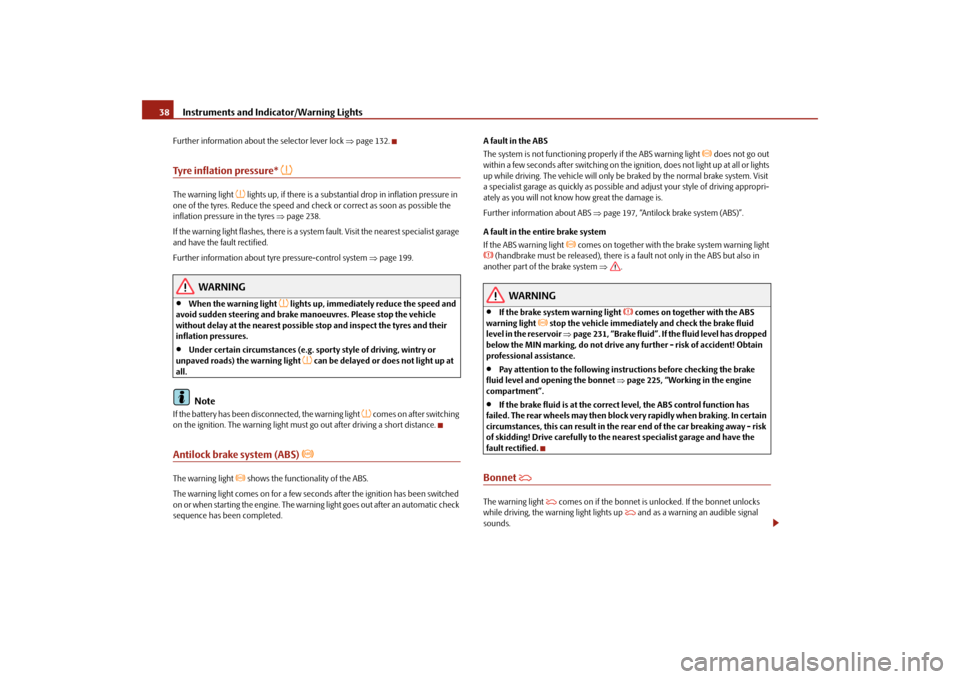
Instruments and Indicator/Warning Lights
38
Further information about the selector lever lock
⇒page 132.
Tyre inflation pressure*
The warning light
lights up, if there is a substantial drop in inflation pressure in
one of the tyres. Reduce the speed and check or correct as soon as possible the inflation pressure in the tyres
⇒page 238.
If the warning light flashes, there is a system fault. Visit the nearest specialist garage and have the fault rectified. Further information about tyre pressure-control system
⇒page 199.
WARNING
•
When the warning light
lights up, immediately reduce the speed and
avoid sudden steering and brake mano
euvres. Please stop the vehicle
without delay at the nearest possible stop and inspect the tyres and their inflation pressures.•
Under certain circumstances (e.g. sporty style of driving, wintry or
unpaved roads) the warning light
can be delayed or does not light up at
all.
Note
If the battery has been disconnected, the warning light
comes on after switching
on the ignition. The warning light must
go out after driving a short distance.
Antilock brake system (ABS)
The warning light
shows the functionality of the ABS.
The warning light comes on for a few second
s after the ignition has been switched
on or when starting the engine. The warning light goes out after an automatic check sequence has been completed.
A fault in the ABS The system is not functioning properly if the ABS warning light
does not go out
within a few seconds after switching on the ig
nition, does not light up at all or lights
up while driving. The vehicle
will only be braked by th
e normal brake system. Visit
a specialist garage as quickly as possible and adjust your style of driving appropri-ately as you will not know how great the damage is. Further information about ABS
⇒page 197, “Antilock brake system (ABS)”.
A fault in the entire brake system If the ABS warning light
comes on together with the brake system warning light
(handbrake must be released), there is a fault not only in the ABS but also in another part of the brake system
⇒
.
WARNING
•
If the brake system warning light
comes on together with the ABS
warning light
stop the vehicle immediately and check the brake fluid
level in the reservoir
⇒page 231, “Brake fluid”. If the fluid level has dropped
below the MIN marking, do not drive any further - risk of accident! Obtain professional assistance.•
Pay attention to the following instru
ctions before checking the brake
fluid level and opening the bonnet
⇒page 225, “Working in the engine
compartment”.•
If the brake fluid is at the correct level, the ABS control function has
failed. The rear wheels may
then block very rapidly when braking. In certain
circumstances, this can result in the rear end of the car breaking away - risk of skidding! Drive carefully to the ne
arest specialist garage and have the
fault rectified.Bonnet
The warning light
comes on if the bonnet is unlocked. If the bonnet unlocks
while driving, the warning light lights up
and as a warning an audible signal
sounds.
se0.1.book Page 38 Friday, April 10, 2009 3:19 PM
Page 41 of 304
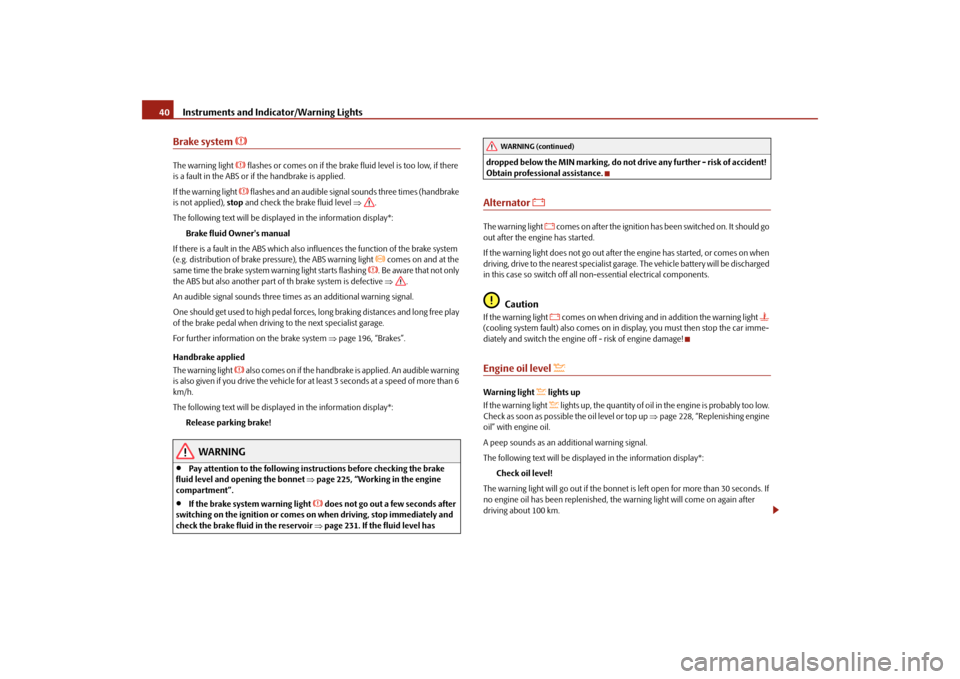
Instruments and Indicator/Warning Lights
40
Brake system
The warning light
flashes or comes on if the brake fluid level is too low, if there
is a fault in the ABS or if
the handbrake is applied.
If the warning light
flashes and an audible signal sounds three times (handbrake
is not applied),
stop
and check the brake fluid level
⇒
.
The following text will be displayed in the information display*:
Brake fluid Owner's manual
If there is a fault in the ABS which also in
fluences the function of the brake system
(e.g. distribution of brake pressure), the ABS warning light
comes on and at the
same time the brake system warning light starts flashing
. Be aware that not only
the ABS but also another part of th brake system is defective
⇒
.
An audible signal sounds three times as an additional warning signal.One should get used to high pedal forces, long braking distances and long free play of the brake pedal when driving to the next specialist garage. For further information on the brake system
⇒page 196, “Brakes”.
Handbrake applied The warning light
also comes on if the handbrake is applied. An audible warning
is also given if you drive the vehicle for at least 3 seconds at a speed of more than 6 km/h. The following text will be displayed in the information display*:
Release parking brake!
WARNING
•
Pay attention to the following instru
ctions before checking the brake
fluid level and opening the bonnet
⇒page 225, “Working in the engine
compartment”.•
If the brake system warning light
does not go out a few seconds after
switching on the ignition or comes on when driving, stop immediately and check the brake fluid in the reservoir
⇒page 231. If the fluid level has
dropped below the MIN marking, do not
drive any further - risk of accident!
Obtain professional assistance.Alternator
The warning light
comes on after the ignition has been switched on. It should go
out after the engine has started. If the warning light does not go out after
the engine has started, or comes on when
driving, drive to the nearest specialist garage. The vehicle battery will be discharged in this case so switch off all non-essential electrical components.
Caution
If the warning light
comes on when driving and in
addition the warning light
(cooling system fault) also comes on in display, you must then stop the car imme- diately and switch the engine off - risk of engine damage!Engine oil level
Warning light
lights up
If the warning light
lights up, the quantity of oil in the engine is probably too low.
Check as soon as possible the oil level or top up
⇒page 228, “Replenishing engine
oil” with engine oil. A peep sounds as an additional warning signal.The following text will be displayed in the information display*:
Check oil level!
The warning light will go out if the bonnet is
left open for more than 30 seconds. If
no engine oil has been replenished, the
warning light will come on again after
driving about 100 km.
WARNING (continued)
se0.1.book Page 40 Friday, April 10, 2009 3:19 PM
Page 49 of 304
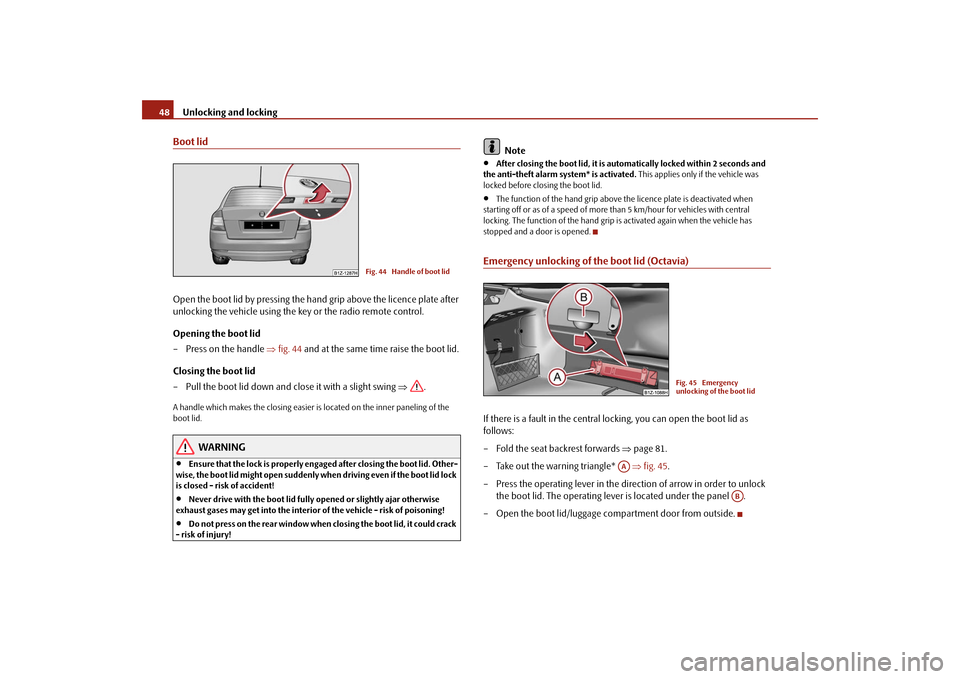
Unlocking and locking
48
Boot lidOpen the boot lid by pressing the hand grip above the licence plate after unlocking the vehicle using the ke
y or the radio remote control.
Opening the boot lid – Press on the handle
⇒
fig. 44
and at the same time raise the boot lid.
Closing the boot lid – Pull the boot lid down and close it with a slight swing
⇒
.
A handle which makes the closing easier is
located on the inner paneling of the
boot lid.
WARNING
•
Ensure that the lock is
properly engaged after clos
ing the boot lid. Other-
wise, the boot lid might open suddenly when
driving even if the boot lid lock
is closed - risk of accident!•
Never drive with the boot lid fully opened or slightly ajar otherwise
exhaust gases may get into the interior of the vehicle - risk of poisoning!•
Do not press on the rear window when closing the boot lid, it could crack
- risk of injury!
Note
•
After closing the boot lid, it is automatically locked within 2 seconds and
the anti-theft alarm
system* is activated.
This applies only if the vehicle was
locked before closing the boot lid.•
The function of the hand grip above the licence plate is deactivated when
starting off or as of a speed of more than 5 km/hour for vehicles with central locking. The function of the hand grip
is activated again when the vehicle has
stopped and a door is opened.Emergency unlocking of the boot lid (Octavia)If there is a fault in the central locking, you can open the boot lid as follows: – Fold the seat backrest forwards
⇒
page 81.
– Take out the warning triangle*
⇒
fig. 45
.
– Press the operating lever in the direction of arrow in order to unlock
the boot lid. The operating lever is located under the panel .
– Open the boot lid/luggage compartment door from outside.
Fig. 44 Handle of boot lid
Fig. 45 Emergency unlocking of the boot lid
AA
AB
se0.1.book Page 48 Friday, April 10, 2009 3:19 PM
Page 50 of 304

Unlocking and locking
49
Using the system
Safety
Driving Tips
General Maintenance
Breakdown assistance
Technical Data
Emergency unlocking of the boot lid (Estate car)If there is a fault in the central lo
cking, you can open the boot lid as
follows: – Fold the seat backrest forwards
⇒
page 81.
– Open up the cover of the lock upwards
⇒
fig. 46
.
– Move the operating lever with th
e aid of a narrow object e.g.
screwdriver up to the stop in the direction of arrow; the boot lid is then unlocked.
– Open the boot lid/luggage compartment door from outside.Remote control*DescriptionYou can use the remote control:•
to unlock and lock the car,
•
unlocking boot lid,
•
electrically open and close the windows.
The transmitter with the battery is housed in the handle of the remote control key. The receiver is located in the interior of
the car. The operating range of the remote
control is approx. 10 m. But this range of
the remote control can be reduced if the
batteries are weak. The remote control key has a fold-open key
bit which can be used for unlocking and
locking the car manually and also for starting the engine. If a lost key is replaced or if the receiv
er unit has been repaired or a new unit
installed, it is then necessary for an authorised Škoda Service Partner to initialise the system. Only after this is it possib
le to again use the remote control.
Note
•
The remote control is automatically deac
tivated when the ignition is switched
on.•
The operation of the remote control may temporarily be affected by interfer-
ence from transmitters close to the car and which operate in the same frequency range (e.g. mobile phone, TV transmitter).•
The battery must be replaced, ideally by
an authorised Škoda Service Partner, if
the central locking or anti-theft alarm system does react to the remote control at less than 3 metres away.•
If the driver door is opened, the vehicle cannot be locked using the remote
control.
Fig. 46 Emergency unlocking of the boot lid
AA
se0.1.book Page 49 Friday, April 10, 2009 3:19 PM
Page 70 of 304

Lights and Visibility
69
Using the system
Safety
Driving Tips
General Maintenance
Breakdown assistance
Technical Data
Windshield wiper and wash systemWindshield wiper You can operate the windscreen wipers and automatic wipe/wash using the windscreen wiper lever.The windscreen wiper lever
⇒
fig. 68
has the following positions:
Finger-operated wiping – If you wish to wipe the windscreen only
briefly
, push the lever into the
sprung position . If you hold the le
ver in the lower position for more
than 1 second, the wiper wipes faster.
Intermittent wiping – Position the lever up into position . – Set with the switch the desired break between the individual wiper
strokes
Slow wipe – Position the lever up into position .
Fa s t w ip e – Position the lever up into position . Automatic wipe/wash for windscreen – Pull the lever towards the steering
wheel into sprung position , the
wash system sprays immediately, the windscreen wiper starts wiping a little later. The wash system and the windscreen wiper operate simultaneously at a speed of more than 120 km/h.
– Release the lever. The windscreen wash system stops and the wiper
continues for another 3 - 4 wiper strokes (depending on the period of spraying of the windscreen). At a speed of more than 2 km/h, the wiper wipes once again* 5 seconds after the last wiper stroke in order to wipe the last drops from the windscreen. This function can be acti-vated/deactivated by a specialist garage.
Rain sensor* – Move the lever into position . – You can set the sensitivity of the sensor individually with switch . Wiping the rear window pane* – Push the lever away from the steering wheel into position - the
widescreen wiper will operate every 6 seconds.
Automatic wipe/wash for the rear window pane* – Press the lever from the steering wheel forward into the sprung posi-
tion , the wash system sprays immediately, the windscreen wiper starts wiping a little later. As long as you hold the lever in this position, the wiper operates as well as the wash system.
– Letting go of the lever will cause the windscreen wash system to stop
and the wiper to continue for another 2 - 3 wiper strokes (depending on the period of spraying of the windscreen).
The lever will stay in
position after releasing it
.
Fig. 68 Windscreen wiper lever
A4
A1
AA
A2
A3
A5
A1
AA
A6
A7
A6
se0.1.book Page 69 Friday, April 10, 2009 3:19 PM
Page 123 of 304

Starting-off and Driving
122
Starting-off and DrivingSetting steering wheel positionYou can set the height and the forward/back position of the steering wheel to the desired position. – Adjust the driver seat
⇒
page 12.
– Pull the lever below the steering column
⇒
fig. 144
down
⇒
.
– Set the steering wheel to the desired position (concerning height and
forward/back position).
– Push the lever upwards as far as the stop.
WARNING
•
You must not adjust the steering wh
eel when the vehicle is moving!
•
The driver must maintain a distance of at least 25 cm to the steering
wheel
⇒fig. 145
. Not maintaining this minimum distance will mean that the
airbag system will not be able to properly protect you - hazard!•
For s afe ty re a so ns t he le ve r m ust al wa y s b e fi rm ly pus he d up to a voi d the
steering wheel alteri
ng its position unintentionally when driving - risk of
accident!•
If you adjust the steering wheel furthe
r towards the head, you will reduce
the protection offered by the driver airb
ag in the event of an accident. Check
that the steering wheel is aligned to the chest.•
When driving, hold the steering wheel
with both hands firmly on the
outer edge in the 9 o'clock and 3 o'clock position. Never hold the steering wheel firmly in the 12 o'clock position or in another way (e.g. in the middle of the steering wheel or at the inner
steering wheel edge). In such cases,
injuries to the arms, the hands and
the head can occur when the driver
airbag is deployed.
Fig. 144 Adjustable steering wheel: Lever below steering columnFig. 145 Safe distance to steering wheel
se0.1.book Page 122 Frida
y, April 10, 2009 3:19 PM
Page 126 of 304
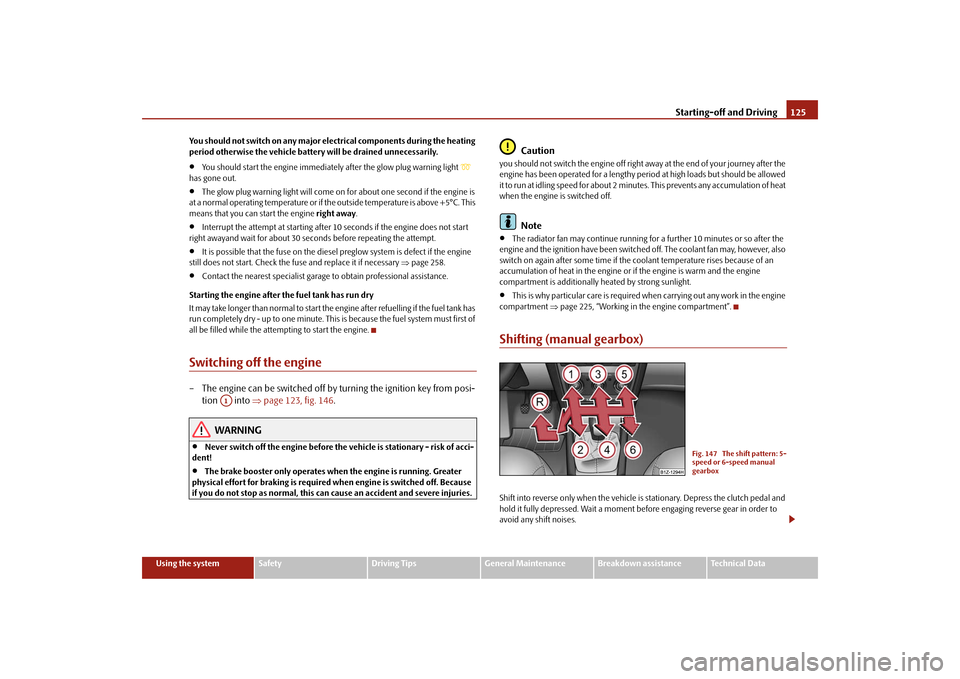
Starting-off and Driving
125
Using the system
Safety
Driving Tips
General Maintenance
Breakdown assistance
Technical Data
You should not switch on any major electrical components during the heating period otherwise the vehicle battery will be drained unnecessarily.•
You should start the engine immediately after the glow plug warning light
has gone out.•
The glow plug warning light will come on for about one second if the engine is
at a normal operating temperature or if th
e outside temperature is above +5°C. This
means that you can start the engine
right away
.
•
Interrupt the attempt at starting after 10 seconds if the engine does not start
right awayand wait for about 30 seconds before repeating the attempt.•
It is possible that the fuse on the diesel
preglow system is defect if the engine
still does not start. Check the fuse and replace it if necessary
⇒page 258.
•
Contact the nearest specialist garage to obtain professional assistance.
Starting the engine after the fuel tank has run dry It may take longer than normal to start the
engine after refuelling if the fuel tank has
run completely dry - up to one minute. This is because the fuel system must first of all be filled while the attempting to start the engine.Switching off the engine– The engine can be switched off by turning the ignition key from posi-
tion into
⇒
page 123, fig. 146
.
WARNING
•
Never switch off the engine before the
vehicle is stationary - risk of acci-
dent!•
The brake booster only operates when the engine is running. Greater
physical effort for braking is required
when engine is switched off. Because
if you do not stop as normal, this can cause an accident and severe injuries.
Caution
you should not switch the engine off right
away at the end of yo
ur journey
after the
engine has been operated for a lengthy peri
od at high loads but should be allowed
it to run at idling speed for about 2 minutes
. This prevents any accumulation of heat
when the engine is switched off.
Note
•
The radiator fan may conti
nue running for a further 10
minutes or
so after the
engine and the ignition have
been switched off. The coolant fan may, however, also
switch on again after some time if the
coolant temperature rises because of an
accumulation of heat in the engine or
if the engine is warm and the engine
compartment is additionally
heated by strong sunlight.
•
This is why particular care is required when carrying out any work in the engine
compartment
⇒page 225, “Working in the engine compartment”.
Shifting (manual gearbox)Shift into reverse only when the vehicle is
stationary. Depress the clutch pedal and
hold it fully depressed. Wait a moment be
fore engaging reverse gear in order to
avoid any shift noises.
A1
Fig. 147 The shift pattern: 5- speed or 6-speed manual gearbox
se0.1.book Page 125 Frida
y, April 10, 2009 3:19 PM